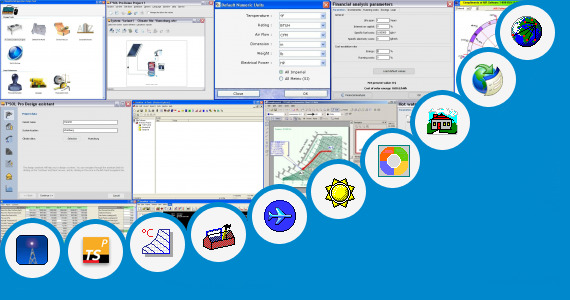Ejector Design Calculation Software

Steam jet ejectors offer a simple, reliable, low-cost way to produce vacuum. They are especially effective in the chemical industry where an on-site supply of the high-pressure motive gas is available. Ejectors are considered an alternative to mechanical vacuum pumps for a number of reasons: • No source of power is required other than the motive gas; • Because they have no moving parts, they are reliable vacuum producers; • They are easy to install, operate and maintain. Ejector Design Very simply, an ejector is a pumping device. It has no moving parts.
Instead, it uses a fluid or gas as a motive force. Very often, the motive fluid is steam and the device is called a “steam jet ejector.” Basic ejector components are the steam chest, nozzle, suction, throat, diffuser and they discharge (Fig. The two major functions of ejectors are as follows: Thermocompressors Thermocompressors are ejectors applied to recompressing spent steam and process fluids. In the compressors recycle waste steam and low-pressure water vapor discharge, reducing energy consumption by 30% or more. Vacuum Producers: Ejector-based systems are particularly appropriate as primary vacuum producers, particularly where motive steam is almost always available.
They are applied in processes such as crystallization, deaeration, drying, cooling, high vacuum distillation and deodorization. Ejector systems range from the simple, single-ejector stage to very complex systems with as many as six ejectors in combination with intercondensers. Ejectors are available in either single-nozzle or multiple-nozzle designs. Single-nozzle units are also available with an automatic spindle for special applications.
The single-nozzle, fixed orifice is the simplest type of ejector. Multiple-nozzle ejectors are more efficient. They usually save as much as 10% to 20% in motive steam, compared with single-nozzle units designed for the same conditions.
In a spindle-operated ejector, the nozzle and tapered spindle work together similar to a needle valve. In this case, the spindle is essentially changing the dimensions of the ejector’s internalities is, creating a new single-point design. For this reason, the spindle-operated ejector provides high off-design efficiency, which is very handy if operating conditions must vary. Multistaged ejectors often promote economy by including intercondensers between some of the stages to reduce the load to the following stages.
Sometimes precondensers, booster condensers and aftercondensers are also used. Condensers Condensers may be barometric or surface.
OPTIMIZATION OF A HIGH-EFFICIENCY JET EJECTOR BY COMPUTATIONAL FLUID DYNAMICS SOFTWARE A Thesis by SOMSAK WATANAWANAVET Submitted to Texas A&M University in partial fulfillment of the requirements for the degree of MASTER OF SCIENCE Approved as to style and content by: _____ Mark T. Holtzapple (Co-Chair of Committee). Aircraft propeller design software.
The size and type of condenser selected is a function of air-vapor ratios, cooling water temperatures available, steam and water costs, and contaminants in the suction vapor. Barometric condensers cost less to buy and install. They have many advantages. However, users should be aware that the barometric condenser is a direct-contact design. The cooling water is mixed directly with the vapor to be condensed. If there are any environmental considerations concerning the process fluid, it should not be mixed with cooling water. The shell-and-tube condenser keeps cooling water separate from the process fluid.
No contamination can occur; thus, the condenser water is cooled and reused. On the other hand, the shell-and-tube design may require more maintenance due to the possibility of scale or solids buildup on the condenser tubes. Ejector Operation: In operation, a high-pressure motive gas enters the steam chest at low velocity and expands through the converging-diverging nozzle. This results in a decrease in pressure and an increase in velocity.
Meanwhile, the suction fluid enters at the suction inlet. The motive fluid, which is now at high velocity, entrains the suction fluid and combines with it. The two fluids are then recompressed through the diffuser.
Potential energy is converted to kinetic energy; thus, velocity increases and pressure decreases. The mixture reaches its maximum velocity and lowest pressure at the Venturi throat (Fig. The fluid then is charges at an intermediate pressure, which is higher than the inlet suction fluid pressure, but much lower than the inlet motive fluid pressure.